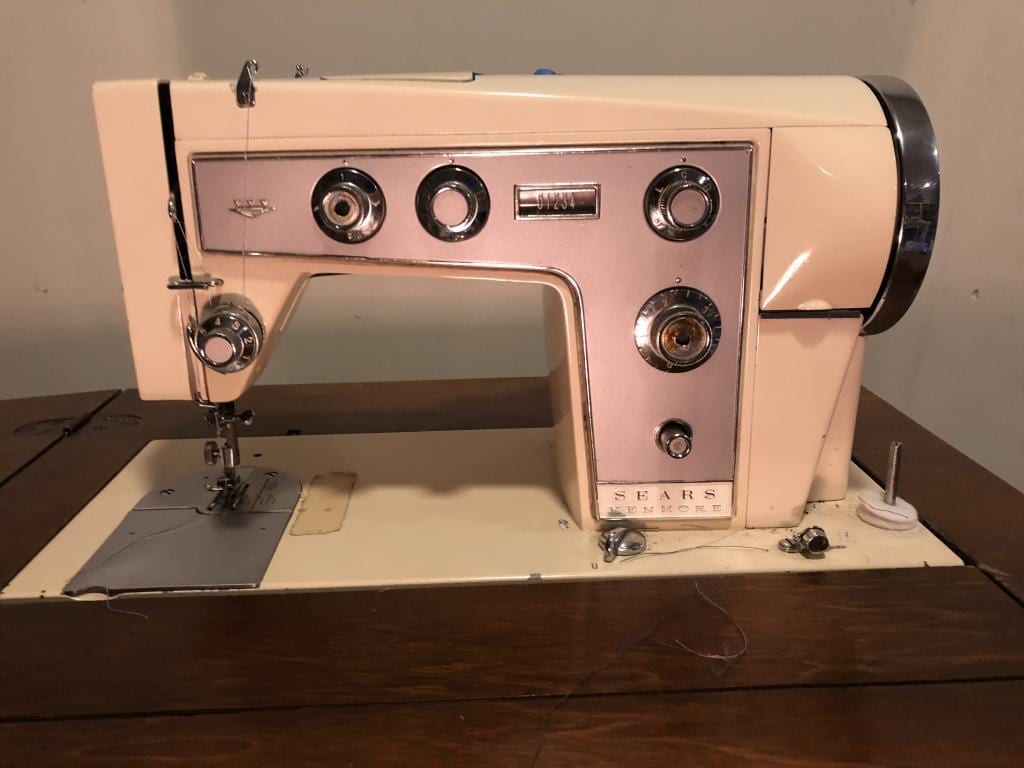
Here’s a bit of an anecdote from the life of Jane the Actuary:
I own a vintage sewing machine — a Kenmore model 158.904 from the 60s which I bought for $25 at a garage sale when it was already old, and have taken along with me from apartment to home to move-up home, since then. It is sorely lacking in bells & whistles — it has cams (templates for making custom stitches) and a buttonhole-making device, but a modern machine would have these features built-in as well as an automated threader, stop-start, and much more. But in addition to sentimental reasons, I’ve held onto it because it is all-metal, has a 1.2 amp motor, and can basically handle anything I throw at it, with respect to thickness of the material, helpful when I’m sewing a kids’ Halloween costume rather than merely a quilting project, for example. (For comparison, even a “heavy duty” modern machine only has a 1.0 amp motor.)
At the same time, though, it has given me more than its fair share of troubles and, over the last several months since I started sewing face masks, has been giving me particular problems with thread bunching (”birds’ nests”), thread breakage, and tension issues that would send spools of thread flying off the holder on the machine, which I could minimize but not solve regardless of how many times I oiled the machine or studied up on YouTube videos or videoed the machine in operation and watched the slow-mo playback. And I kept asking myself and lamenting to my husband: “I’ve always had issues with tension. But I’ve never had this particular issue before; I’ve never had a spool of thread fly off.”
Finally, just the other day, I switched to another type of project, and another type of stitch, which gave me the insight I needed. Reader, common sense would dictate that, when installing a needle, one inserts it as far into the needle slot as it fits, so that it is as stable and secure as possible. But, it turns out, that had been my mistake all along — the needle was too high, and the “hook” was not picking up the thread consistently. I lowered the needle a slight bit, did some test stitches, and the machine worked flawlessly. (In hindsight, early on in the face-mask sewing, I broke a needle. What caused that I don’t know, as that hadn’t happened before, but my installing that needle might have started this whole issue. Or maybe not; in any case, I think in a modern machine, there is a proper adjustment lever.)
Or at least it did last night. Fingers-crossed that’s true when I sew more than a test swatch.
Why do I tell this story?
My Forbes article from earlier this week, on the implications for pension liabilities of a “disband the Chicago police” strategy, I titled, “Defund The Police, Cut Pension Liabilities? The One Weird Trick That Just Might Work For Chicago,” in an ironic reference to the countless gimmicky articles claiming to offer “one weird trick” for weight loss or the like. I think at this point, readers of internet advertisements do understand that there is no “one weird trick” that provides easy answers.
But we nonetheless too often want all our problems to have “one weird trick” that solves them, something easily achievable if only someone smart enough thinks of it, in the way in which I struggled to find, and, yes, ultimately did find, the “weird trick” to fixing my sewing machine.
It’s the old bit about “if we can put a man on the moon, we can also solve [intractable social problem].” The “man on the moon” is a matter of engineering, of math, it’s my “surely my sewing machine, as a machine, is fixable” issue on a much larger scale.
But “fixing” the fact that black Americans have a greater poverty level and lower median income than white Americans? And make no mistake – the discussion among politicians and pundits and policy experts of various kinds has moved beyond implementing another round of reform in policing to the insistence that this larger issue has to be solved right away and, generally speaking, by means of either the conversion of the United States into an extreme version of a European social welfare system, or the provision of those benefits specifically to descendants of slavery.
And this drives me batty – all the more so because those lauded social welfare systems, such as Sweden, have the very same sorts of challenges with their ethnic minorities’ economic situation, in particular, with respect to immigrants from Muslim countries. Asian countries are just as likely to be racist, even if their labeling of “race” doesn’t conform to the labels we consider to be universal. I know everyone would like to believe that if we were just willing to pull this one lever we haven’t pulled, we’d be able to fix this, but I just don’t see that happening. I don’t even see any “role model” countries.
Humans aren’t machines. We can’t make an adjustment to the gears to fix us.
As to what I think should happen? I haven’t got a clue. Honestly, seriously, I don’t know. I know to be very wary of unintended consequences. I know that those folks who care deeply and passionately about the issue can’t be deemed more likely to have the answers just because they care more, and I know that even people “in the trenches” can be mistaken about what the answers are, especially if they see the people they’re trying to help always in the best light possible. (Pet peeve: everyone promoting maintaining the $600/week bonus unemployment benefit and insisting that because people are basically good, they will come back to their jobs even if it means a loss of income.) I know that I can dig into numbers but can’t myself, personally, throw myself into some sort of “community organizing” work because it would be a sure guarantee that I’d screw it up and have everyone mad at me for not saying the right things. And, frankly, it worries me that every institution — every corporation, every small business, every charity, every museum — is now being called upon toe make this their cause even when they have no particular expertise and should focus instead on what they can actually do with effectiveness.
Finally, tangentially, as a related update, I’ve been sewing face masks. My current tally is 150-ish given away. To be honest, I’ve mostly stopped, now that they are available in stores, in either reusable or disposable versions, for decently affordable prices, and they seem to also be providing an income for some otherwise unemployed folk. (One reads reports of garment-industry manufacturers switching to face masks, and I also notice that the ones the local dry cleaners are selling appear hand-sewn rather than imported from China.) I’m considering sewing a few for the food pantry collection later today, simply because, when in the bathroom at the grocery store the other day, I saw a woman who, honestly, looked on the poorer side of things, taking off her disposable face mask, and it was grimy and clear that she’d been reusing it repeatedly. Which means that the need is less clear.












